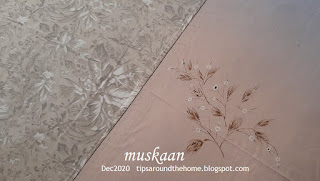The year was such a mishmash, such a dump in many ways and creative individuals took refuge in their arts and crafts.
Thursday, 31 December 2020
mishmash 2020
Sunday, 27 December 2020
all links restored
O Happy Happy ! ! !
You have all been so very patient all these months. Now, after Six whole months there is no need to edit blogspot.in to blogspot.com when a link does not work.
My usual tech-related problem solvers are Ninetta and Robin, and Ninetta informed me of broken links a couple of days after I had discovered them in late May. Then almost immediately I received a surprise email from ManTatter (from Craftree) offering to help me with the changes! He explained the process very clearly as well.Monday, 21 December 2020
embroidered motifs
This is from another lifetime...so long back that I cannot remember exactly when. All I know for certain is I started embroidering these hankies in 1996. Yup, a lifetime back!
These are not my original patterns, though I might've adapted them a bit here and there. I've given them names just for fun ;-P
Orange Pansy
Hand-embroidered in single strand of vintage silk thread.This is an older image to show the sheen of silk threads.
The wear and tear is clearly visible. While the sheen does not wear off, the vintage silk thread can fray.
Sunday, 13 December 2020
hiding fabric burn spots
Friday, 4 December 2020
picot join to right part 4
I haven’t picked up my shuttles in a long time despite spending all my free time in tatting-related activities and interaction. And I’ve been neglecting my blog, too – can’t let that happen!
Well over a week back, this is what I made quickly for an experienced friend. She, too, like I, avoids the folded join when making a picot join to the right. I prefer to rotate the work slightly on my hand, repositioning the picot on the right such that it now comes to the left, and then execute the join normally. These are my detailed pictorials and article on the topic -
http://www.tipsaroundthehome.blogspot.com2016/03/demystifying-joins.html - about picot joinhttps://tipsaroundthehome.blogspot.com/2018/09/picot-join-to-right-part1.html - outward facing rigs
https://tipsaroundthehome.blogspot.com/2018/09/picot-join-to-right-part-2.html - chains and down join
https://tipsaroundthehome.blogspot.com/2018/10/picot-join-to-right-part-3.html - where we need this join.
What I did not explicitly show in Part 2 was what happens when all rings face inwards. She was under the impression that 'with inward facing rings no such rotation is required to execute the final join since we are working counterclockwise'. Visuals are better than words, hence …
Picot Join to the Right – Part 4
(joining last inward facing ring to the first using Rotate Work)
5. Since we are avoiding the folded join, notice the slight counterclockwise rotation of motif while still in hand, to reach the picot. The movement is so subtle, that it goes unnoticed, unlike in a rosette with outward facing rings (Part 1)























